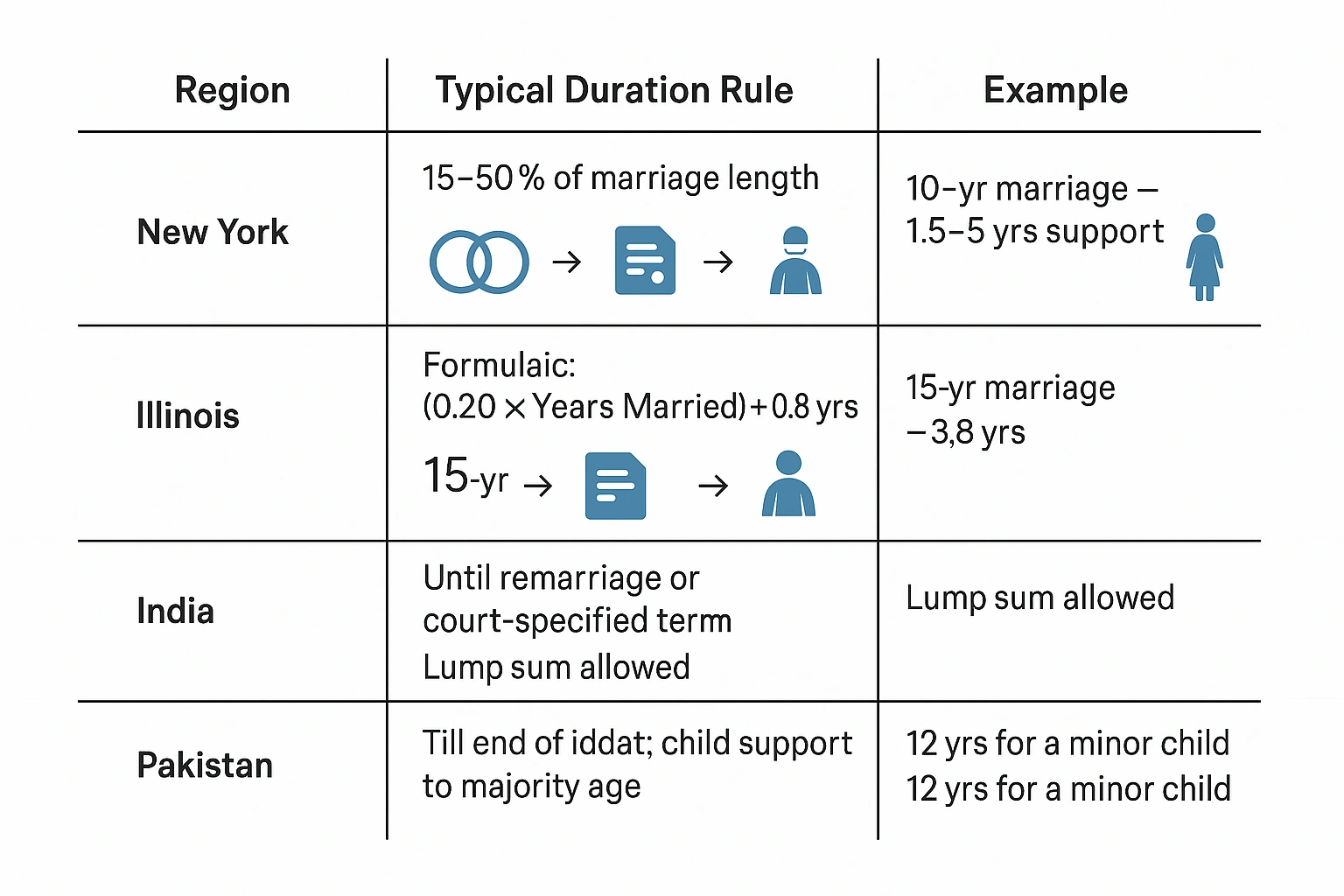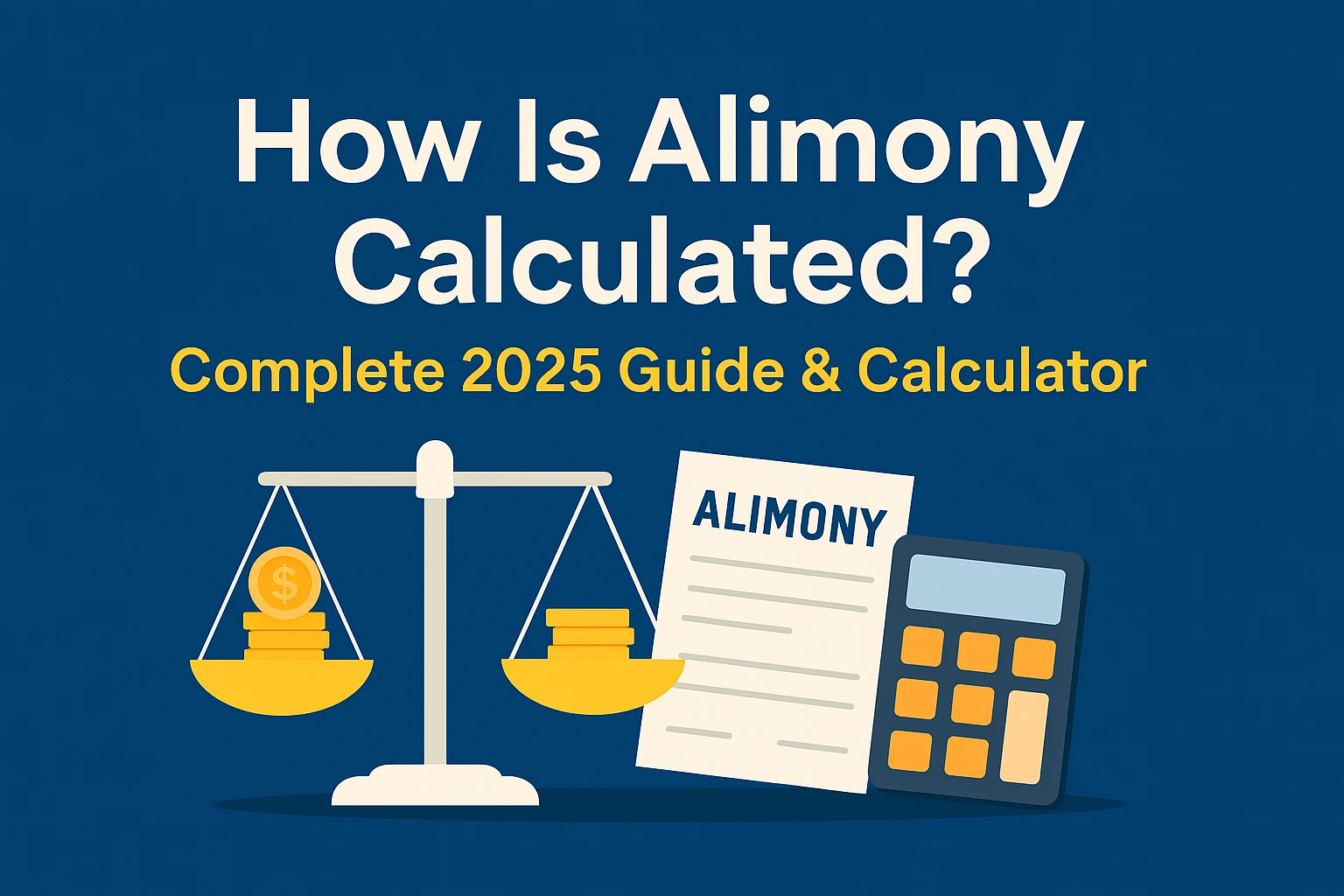Understanding How Is Alimony Calculated?
Alimony also known as spousal support or maintenance is a court‑ordered payment one spouse makes to the other after separation or divorce. Its core aim is to mitigate unfair economic impact by balancing income disparities that developed during the marriage. Unlike child support, alimony focuses on the spouse’s needs rather than children’s.
Types of Alimony
- Temporary (Pendente Lite): Paid while divorce proceedings are ongoing.
- Rehabilitative: Supports the recipient until they gain self‑sufficiency (e.g., finishing education).
- Permanent: Indefinite payments, usually after long marriages.
- Reimbursement: Repays one spouse for expenses (e.g., medical school tuition) shouldered during marriage.
2. Core Factors Courts Consider
Courts rarely rely on a single number. They weigh qualitative and quantitative factors, including:
- Income & Earning Capacity: Current net income, potential income (imputed when under‑employed), bonuses, and passive earnings.
- Length of Marriage: Short‑term (<5 yrs), mid‑term (5–20 yrs), long‑term (>20 yrs) trigger different presumptions.
- Age & Health: Chronic illness or advanced age can increase duration or amount.
- Standard of Living: Lifestyle established during marriage (housing, travel, education).
- Child Custody & Care: Primary caretaker may need additional support.
- Contributions to Marriage: Non‑monetary roles such as homemaking or supporting a spouse’s career.
- Fault or Misconduct: Considered only in fault‑based U.S. states and some personal‑law systems.
See full guide on financial disclosure for divorce for step‑by‑step worksheets.
3. Formulas & Statutory Guidelines
The following table summarizes key 2025 formulas. Amounts are annual unless noted.
| Jurisdiction | Calculation Formula | Income Cap / Special Rule | Primary Authority |
|---|---|---|---|
| New York | Lesser of:• (30 % Payor – 20 % Payee)• 40 % Combined Income – Payee | First $228,000 of payor’s income | NY DRL §236‑B(5‑a) |
| Illinois | (33⅓ % Payor – 25 % Payee) AND result + Payee Income ≤ 40 % Combined Net | 40 % combined net cap | 750 ILCS 5/504 |
| India | Generally 25–33 % of Payor’s net salary (judge discretion) | Judges consider lifestyle & needs | Rajnesh v. Neha (2020) SC |
| Pakistan | “Basic needs” maintenance during iddat (~4 mo 10 d) + child support | Amount varies regionally | Muslim Family Laws Ordinance (1961) |
4. Try the Free Alimony Calculator
Enter your details below to generate an estimated monthly payment. Disclaimer: Results are informational and not a substitute for legal advice.
Alimony Calculation Tool
Please enter a valid positive number for Payor’s Income.
Please enter a valid positive number for Payee’s Income.
Please enter a valid positive number for Marriage Duration.
An unexpected error occurred. Please try again.
The selection of a US State or Country in this tool is for **informational context only** and **DOES NOT alter the underlying calculation logic**, which remains generic. This tool is **NOT legal advice**.
**You MUST consult with a qualified legal professional in your specific jurisdiction for accurate and personalized guidance regarding alimony.**
5. How Long Does Alimony Last?

| Region | Typical Duration Rule | Example |
| New York | 15–50 % of marriage length | 10‑yr marriage → 1.5–5 yrs support |
| Illinois | Formulaic: (0.20 × Years Married) + 0.8 yrs | 15‑yr marriage → 3.8 yrs |
| India | Until remarriage or court‑specified term | Lump sum allowed |
| Pakistan | Till end of iddat; child support to majority age | 12 yrs for a minor child |
6. Country‑Specific Insights
United States Highlights
- Community‑property vs. equitable‑distribution states influence outcome.
- Tax treatment: Post‑2019 payors cannot deduct alimony; recipients do not report as income.
- Enforcement tools include wage garnishment and contempt orders.
India Highlights
- Separate personal laws for Hindu, Muslim, Christian, and Parsi communities.
- Interim maintenance possible during trial.
- Courts may order education expenses for children under Section 26 HMA.
Pakistan Highlights
- Support during iddat is obligatory; courts may extend for lactating mothers.
- Maintenance for children calculated separately under the Guardians and Wards Act.
- Non‑payment can lead to arrest warrants or property attachment.
7. Real‑World How is Alimony Calculated Examples
Example 1: New York
Payor net income: $180,000 • Payee net income: $40,000
Calc A: 30 % × 180,000 – 20 % × 40,000 = 54,000 – 8,000 = $46,000
Calc B: 40 % × (180,000 + 40,000) – 40,000 = 88,000 – 40,000 = $48,000
Annual Alimony: $46,000 → $3,833 / month.
Duration: 35 % × 12‑yr marriage ≈ 4.2 yrs.
Example 2: Illinois (Dual‑earner mid‑income scenario)
Payor net: $90,000 • Payee net: $30,000 → Annual support: (0.333 × 90,000) – (0.25 × 30,000) = 29,970 – 7,500 = $22,470 (cap test satisfied).
Example 3: India
Husband net salary: ₹1,200,000 • Wife no income → Court awards 30 % ≈ ₹360,000/yr (₹30,000/month) until wife gains employment.
Example 4: Pakistan
Husband net salary: ₨1,500,000 • Wife supports two children → Court orders ₨375,000 annual spousal maintenance during iddat + ₨500,000 child support for minors.
8. Accuracy of Online Calculators
Calculators streamline preliminary budgeting but lack nuance. They cannot weigh:
- Health issues affecting employability.
- Hidden or fluctuating income streams.
- Regional judicial discretion.
When to rely on professional advice: complex assets, self‑employment income, cross‑border marriages.
Top free tools for comparison:
- NY Court Maintenance Calculator (nycourts.gov)
- Illinois Divorce Maintenance Estimator (illinoislegalaid.org)
9. Frequently Asked Questions
Q1. Can alimony be modified after the decree?
Yes. A substantial change in circumstances—job loss, health crisis—can justify modification.
Q2. Is alimony taxable?
In the U.S., payments finalized after 1 Jan 2019 are not tax‑deductible for payors nor taxable for recipients. Tax rules differ internationally.
Q3. What happens if alimony is unpaid?
Courts may garnish wages, seize property, or impose contempt sanctions.
Q4. What is the formula to calculate alimony?
There is no single universal formula for calculating alimony, as the process varies by jurisdiction. However, many U.S. states use a guideline-based formula to estimate temporary spousal support. For example, a common model is:
Alimony = (40% of Payor’s Income) – (50% of Payee’s Income)This is often adjusted based on marital duration, standard of living, tax implications, and specific local laws. In India and Pakistan, alimony (also known as maintenance) is determined more subjectively by the court based on need, income disparity, and religious/personal laws.
Always consult with a local family lawyer to understand how alimony is calculated in your region.
Q5. Does every ex-wife get alimony?
No, not every ex-wife automatically receives alimony. Courts consider many factors, such as:
- The length of the marriage
- Each spouse’s income and earning capacity
- Whether one spouse sacrificed career opportunities
- Health, age, and standard of living during marriage
- Childcare responsibilities
Alimony is meant to balance financial inequities after divorce—not to serve as a guaranteed payment. In short marriages or where both spouses are self-sufficient, courts often deny alimony altogether.
Q6. How much do most people get for alimony?
There’s no fixed amount that “most people” receive, as alimony payments vary widely based on income, lifestyle, and local laws. However, average payments in the U.S. typically range from 10% to 30% of the paying spouse’s income.
In long-term marriages with a significant income gap, monthly payments can be substantial and sometimes last for years. In contrast, short-term marriages or equal-income situations may result in temporary or no alimony at all.
Using an alimony calculator or speaking with a legal expert can help estimate what’s typical in your jurisdiction and situation.
10. Conclusion
Understanding how alimony is calculated in different regions is crucial for anyone navigating divorce or separation. While formulas offer a helpful baseline—especially in jurisdictions like New York and Illinois courts ultimately tailor decisions based on a wide range of factors, from earning potential and marital duration to health, standard of living, and parental responsibilities.
In India and Pakistan, judicial discretion plays a larger role, especially under varying personal laws and cultural norms. This makes professional legal guidance even more essential.
Online calculators can provide fast approximations, but they often miss critical context like hidden income, unusual expenses, or non-financial contributions during marriage. They also cannot account for nuanced legal considerations, such as tax treatment, remarriage clauses, or enforceability in cross-border divorces.
If you’re beginning the process of determining or disputing spousal support, take the following steps:
- Use our jurisdiction-specific calculator to get a ballpark estimate.
- Gather financial records and evidence of income, assets, debts, and living standards.
- Consult a family-law attorney who understands local statutes and recent case law.
Whether you’re the payor or payee, informed planning ensures a fairer outcome and reduces the risk of future legal complications.





